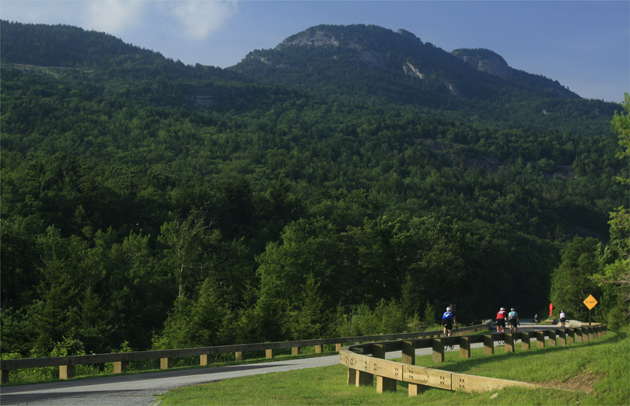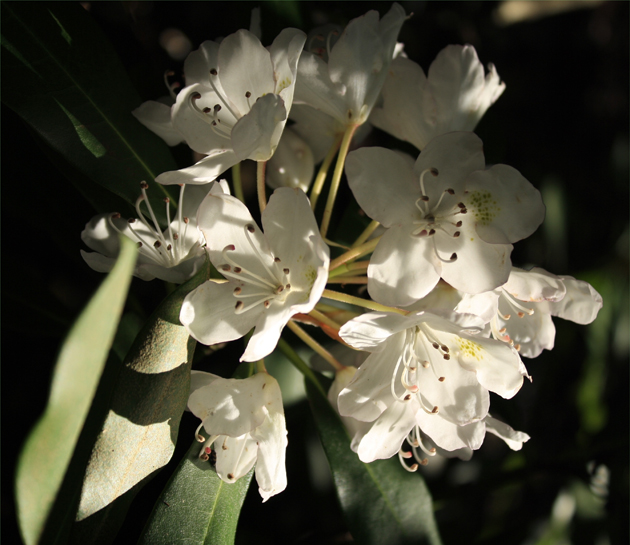Publisher's note: We believe the subject of history makes people (i.e., American people) smarter, so in our quest to educate others, we will provide excerpts from the
North Carolina History Project, an online publication of the
John Locke Foundation. This instalment is provided by Jonathan Martin of the North Carolina History Project.
A route that extends 469 miles through the Virginia and North Carolina mountains, the Blue Ridge Parkway has remained what historian William Powell describes as a travel experience "never to be forgotten" (p. 133). Colonel Joseph Hyde Pratt first suggested the parkway in 1912, but the complete mountain highway was not finished until 1987. As a public road free of industrial development and a park showcasing mountain views of the Blue Ridge, the parkway remains one of western North Carolina's most popular tourist destinations and cultural attractions.
 Grandfather mountain from the Julian Price Memorial Park: Above. The Blue Ridge Parkway is not only for cars but self-propelled bikers as well: Below. photos by Stan Deatherage Click the picture to expand to as much as 1000 pixels wide in most expanded images.
Grandfather mountain from the Julian Price Memorial Park: Above. The Blue Ridge Parkway is not only for cars but self-propelled bikers as well: Below. photos by Stan Deatherage Click the picture to expand to as much as 1000 pixels wide in most expanded images.

Originally known as the "Crest of the Blue Ridge Highway," the mountain road was the brainchild of Col. Joseph Pratt who headed the North Carolina Geological and Economic Survey in the 1910s. Pratt wanted the road--approximately 350 miles--to transverse through the Appalachian mountains, beginning in Marion, Virginia, and ending in Cornelia, Georgia. Crossing through locations such as Linville, Grandfather Mountain, and the Great Craggy Mountains, the parkway's route was "to provide views of the finest mountain scenery in the eastern United States," according to William Powell.
Despite Joseph Pratt's work and surveys, the Crest of the Blue Ridge undertaking was postponed as attention was diverted to winning World War I. (Today, a section of the Blue Ridge Parkway follows a section of Pratt's initial route plan). In 1933, President Franklin Roosevelt toured the unfinished project, and he made plans for the U.S. government to assist in the road's construction. At the behest of Virginia Senator Harry Byrd, the revised plan included the Virginia Shenandoah National Park. Interior Secretary Harold Ickes endorsed the project on November 24, 1933.
 Here a squad of "bikers" make their way north up the Blue Ridge Parkway with the southeast face of Grandfather Mountain in the backdrop. Image was made from the parking area for Beacon Heights overlook: Above. On the path to the big, bare rock Beacon Heights overlook, a July Rhododendron foofer a splash a beauty and a wonderful scent: Below. photos by Stan Deatherage Click the picture to expand to as much as 1000 pixels wide in most expanded images.
Here a squad of "bikers" make their way north up the Blue Ridge Parkway with the southeast face of Grandfather Mountain in the backdrop. Image was made from the parking area for Beacon Heights overlook: Above. On the path to the big, bare rock Beacon Heights overlook, a July Rhododendron foofer a splash a beauty and a wonderful scent: Below. photos by Stan Deatherage Click the picture to expand to as much as 1000 pixels wide in most expanded images.

Federal monies fostered a disagreement between Tennessee and North Carolina in regards to the exact path of the final route. Both states wanted tourists to spend money within its respective borders. So both state governments and private citizens lobbied the federal government to construct the road in Tennessee or North Carolina. With the final say, Ickes decided in favor of North Carolina, and the New Deal's Public Work Administration began construction in 1935.
The federal government provided $4 million to the construction of the parkway, and Stanley L. Abbott was selected as the route overseer. Abbott succeeded in providing a series of parks and rest areas on the parkway and ensuring that many scenic views were available for motorists. Due to his work and organization of the project, Stanly L. Abbott is considered the "father of the Blue Ridge Parkway" (History of the Parkway).
According to the National Park Service, the first step in construction occurred on September 11, 1935, when workers started on a small part of the road near the Cumberland Gap. Due to delay of acquiring land for the roadway, the Blue Ridge project was not a connected venture; the construction was split into forty-five building segments. Originally known as the Appalachian Scenic Highway program, Congress passed the maintenance of the route to the National Park Service and renamed the route the Blue Ridge Parkway on June 30, 1936.
During World War II, construction stopped. Workers enlisted in the military and funds were reallocated to the war effort. Although nearly 170 miles of the parkway were open, the government prohibited recreational travel along the route. After the war, workers returned at a sub-optimal rate, and new equipment proved hard to acquire. Yet, the National Park Service revamped construction in the mid-50s with a new development project mission.
Known as Mission 66, the ten-year enterprise succeeded in increasing construction, and $16 million was spent to finish most of the remaining Blue Ridge Parkway. According to the National Park Service only eight miles were left unfinished by the time of Mission 66's completion. In addition to nearly finishing the roadway, the mission succeeded in adding visitor centers, lodges, and campgrounds along the park's route.
The only part that was missing to the Blue Ridge Parkway remained a section that passed by the base of the Grandfather Mountain. After architects gathered and developed a roadway blueprint, construction of the Linn Cove Viaduct started in the late 1970s. The iconic viaduct was finished in 1987, opening the entire Blue Ridge Parkway to tourist travel. The parkway remains an important attraction of the National Park Service as well as an economic impetus to the surrounding western North Carolina region.
Sources:
"Blue Ridge Parkway." North Carolina Highway Historical Marker Program website. A Division of the North Carolina Department of Cultural Resources. http://www.ncmarkers.com/Results.aspx?k=Search&ct=btn, (Accessed March 14, 2012); "Blue Ridge Parkway." William S. Powell, ed. Encyclopedia of North Carolina (University of North Carolina Press: Chapel Hill, NC 2006); "History of the Parkway." Blue Ridge Parkway 75th Anniversary website. http://blueridgeparkway75.org/more-than-a-road/history/, (Accessed March 14, 2012).
























